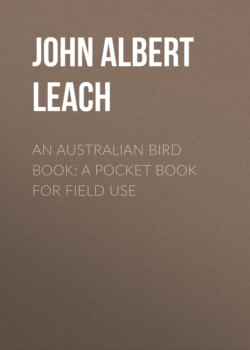Читать книгу An Australian Bird Book: A Pocket Book for Field Use - John Albert Leach - Страница 14
На сайте Литреса книга снята с продажи.
ORDER I.—CASUARIIFORMES.
ОглавлениеTable of Contents
F. 3. DROMAEIDAE (1), EMU, 1 sp. A.
1
1
1 Emu, Dromaius novae-hollandiae, A.
Stat. r. plains 78
See diagram, second largest living bird; f., smaller. Fruits, grass.
F. 4. CASUARIIDAE (1), CASSOWARY, 17 sp. A.
F. 5. Apterygidae, Apteryx, Kiwi, 6 sp. A. (N.Z.).
F. 6. Tinamidae, Tinamous, 69 sp. Nl.
The birds of the second order are well known as "scratchers." They include the domestic fowl, which has been derived from the wild jungle fowl of India, and other fowl, such as the peafowl. Quail are also included here; so are Pheasants. The absence of Pheasants from Australia is more than compensated for by the presence of the Mound-Builders. These marvellous birds, Brush Turkeys and Mallee-Fowl, retain the reptilian characteristic of not sitting on their eggs. Thus the young have never known their parents. The eggs are laid in a huge mound of sand and earth, which contains rotting vegetation. The heat of decomposition in this remarkable natural incubator, is quite sufficient to hatch the eggs. The young are born fully feathered, able to run at once, and able to fly the day they leave the mound. Contrast their stage of development with that of a pigeon born naked, blind, and helpless, and that of a chick born clothed with down and able to run about. There is an interesting connexion between the size of an egg and the state of development of the young bird at birth. The pigeon lays a relatively small egg, so the young pigeon does not develop far in the egg, and requires much maternal care. The hen's egg is larger, and the chick is more fully developed. The Mallee-Hen's egg is enormous, and so the young can develop much further before birth. This bird, unfortunately, is doomed to early extinction, for the fox has discovered the rich store of food in the eggs, and country dwellers have also discovered that they are delicate in flavor, and are good food. It is hoped that the scrubby western end of Kangaroo Island, where foxes are unknown, will prove a suitable sanctuary for them. These birds, which rank among Nature's wonders, are almost confined to the Australian region. One is found in Borneo and the Philippines, while a second is confined to the distant Nicobar Islands. Twenty-six live in Australia and its neighboring islands. One of these has spread across Wallace's line to the small Kangean Island, near Java. The Stubble Quail, a member of the Pheasant family, is nearly identical with the British Quail. Mathews and Campbell make the King Quail a sub-species of the Chinese Quail.
Quail are favorite sporting birds, but when one considers that they are worth about 9d. each as table or game birds, and that sportsmen found at Birregurra, that the crops of Quail were full of crickets, and at Kerang the Quail contained numbers of a species of weevil, it is doubtful if it is wise policy to shoot this insect-eating bird. Although it may be worth a few pence as a table bird; it is worth many shillings as a pest destroyer.
